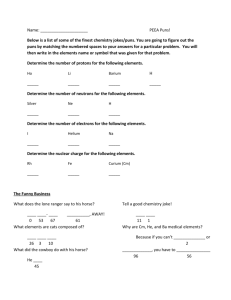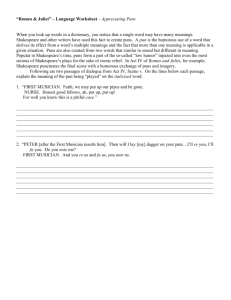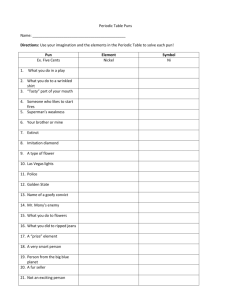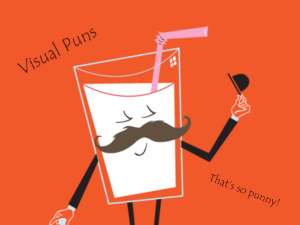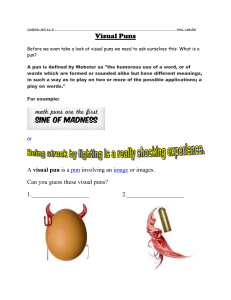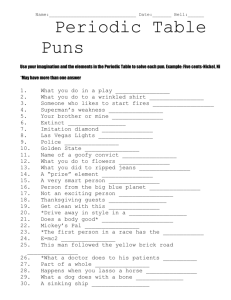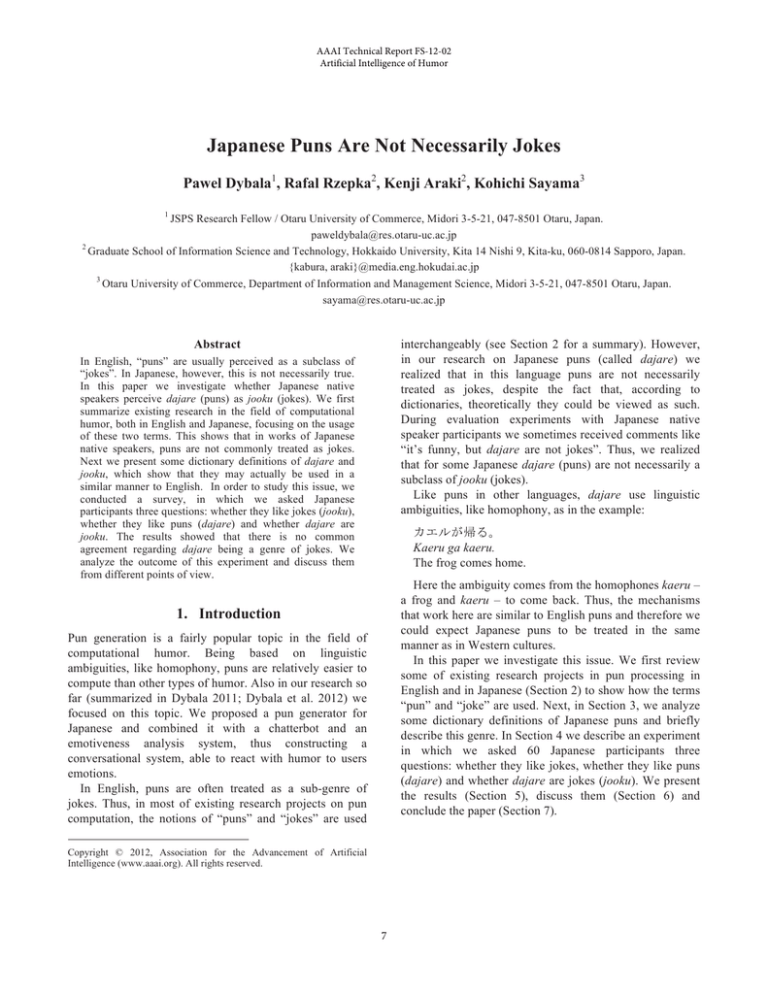
AAAI Technical Report FS-12-02
Artificial Intelligence of Humor
Japanese Puns Are Not Necessarily Jokes
Pawel Dybala1, Rafal Rzepka2, Kenji Araki2, Kohichi Sayama3
1
JSPS Research Fellow / Otaru University of Commerce, Midori 3-5-21, 047-8501 Otaru, Japan.
paweldybala@res.otaru-uc.ac.jp
2
Graduate School of Information Science and Technology, Hokkaido University, Kita 14 Nishi 9, Kita-ku, 060-0814 Sapporo, Japan.
{kabura, araki}@media.eng.hokudai.ac.jp
3
Otaru University of Commerce, Department of Information and Management Science, Midori 3-5-21, 047-8501 Otaru, Japan.
sayama@res.otaru-uc.ac.jp
Abstract
interchangeably (see Section 2 for a summary). However,
in our research on Japanese puns (called dajare) we
realized that in this language puns are not necessarily
treated as jokes, despite the fact that, according to
dictionaries, theoretically they could be viewed as such.
During evaluation experiments with Japanese native
speaker participants we sometimes received comments like
“it’s funny, but dajare are not jokes”. Thus, we realized
that for some Japanese dajare (puns) are not necessarily a
subclass of jooku (jokes).
Like puns in other languages, dajare use linguistic
ambiguities, like homophony, as in the example:
In English, “puns” are usually perceived as a subclass of
“jokes”. In Japanese, however, this is not necessarily true.
In this paper we investigate whether Japanese native
speakers perceive dajare (puns) as jooku (jokes). We first
summarize existing research in the field of computational
humor, both in English and Japanese, focusing on the usage
of these two terms. This shows that in works of Japanese
native speakers, puns are not commonly treated as jokes.
Next we present some dictionary definitions of dajare and
jooku, which show that they may actually be used in a
similar manner to English. In order to study this issue, we
conducted a survey, in which we asked Japanese
participants three questions: whether they like jokes (jooku),
whether they like puns (dajare) and whether dajare are
jooku. The results showed that there is no common
agreement regarding dajare being a genre of jokes. We
analyze the outcome of this experiment and discuss them
from different points of view.
Kaeru ga kaeru.
The frog comes home.
Here the ambiguity comes from the homophones kaeru –
a frog and kaeru – to come back. Thus, the mechanisms
that work here are similar to English puns and therefore we
could expect Japanese puns to be treated in the same
manner as in Western cultures.
In this paper we investigate this issue. We first review
some of existing research projects in pun processing in
English and in Japanese (Section 2) to show how the terms
“pun” and “joke” are used. Next, in Section 3, we analyze
some dictionary definitions of Japanese puns and briefly
describe this genre. In Section 4 we describe an experiment
in which we asked 60 Japanese participants three
questions: whether they like jokes, whether they like puns
(dajare) and whether dajare are jokes (jooku). We present
the results (Section 5), discuss them (Section 6) and
conclude the paper (Section 7).
1. Introduction
Pun generation is a fairly popular topic in the field of
computational humor. Being based on linguistic
ambiguities, like homophony, puns are relatively easier to
compute than other types of humor. Also in our research so
far (summarized in Dybala 2011; Dybala et al. 2012) we
focused on this topic. We proposed a pun generator for
Japanese and combined it with a chatterbot and an
emotiveness analysis system, thus constructing a
conversational system, able to react with humor to users
emotions.
In English, puns are often treated as a sub-genre of
jokes. Thus, in most of existing research projects on pun
computation, the notions of “puns” and “jokes” are used
Copyright © 2012, Association for the Advancement of Artificial
Intelligence (www.aaai.org). All rights reserved.
7
2.
2.2.1 In works of native speakers
In general, Japanese native speakers tend to avoid calling
puns (dajare) jokes (jooku) in publications both in English
and in Japanese. This is consistent with our experience in
research on dajare generation (see above).
Tanabe, for instance, who proposed an algorithm of a
dajare generating system (Tanabe 2005), uses the notions
“puns” (in the title and English abstract of his work) and
“dajare” (in the paper body in Japanese). The author does
not use the words “joke” or “jooku” at all.
In their work on punning riddles generation in Japanese,
Hamada and Onisawa (2008) consequently use the word
“nazonazo” (Japanese for “punning riddles”) to refer to
their output; however, they also mention some similar
genres of humor, including dajare. There is no reference to
jokes (jooku) anywhere in the paper.
Albeit the work by Shinohara and Kawahara (2010) is
not directly related to computational humor, its findings
seem usable also in this field. The paper, written in English,
reports a corpus-based study of a particular pattern in
dajare, which are referred to as “Japanese puns”. Also in
this work no term “joke” is used.
“Puns” and “Jokes” in Existing
Research on Computational Humor
In this section we briefly summarize some of existing
works in the field of computational humor both in English
(2.1) and in Japanese (2.2). We focus on how the notions
of “puns” and “jokes” are used.
2.1 In English
As mentioned above, in existing research on pun
processing in English treating “puns” as “jokes” is rather
common. So does Binsted in her works on punning riddles
generator, one of the first and best known in this field of
study (Binsted 1996). The author also used the word “joke”
in the system’s name JAPE, which is an acronym of “Joke
Analysis and Production Engine”. Thus, punning riddles
are treated here as a subgenre of jokes.
JAPE’s algorithm was significantly improved and
reimplemented by Ritchie et al. (2007), who created
STANDUP: an interactive riddle builder for children with
cerebral palsy. Following the notion used by Binsted, the
authors consequently used the term “jokes” to as a
hypernym for “puns”. Ritchie also treats puns as a subtype
of jokes in his other works, e.g. (Ritchie 2005, Ritchie
2009; in the latter he uses the term “wordplay jokes”).
McKay (2002) in his works on WISCRAIC idiom based
witticisms generator defines wits as a subclass of puns,
which in turn are treated as a subclass of jokes. Thus, the
term “joke” here is often used to refer to the wits (puns)
generated by the system.
As showed on above examples, in the field of
computational humor in English puns generally are treated
as a subclass of jokes. To our best knowledge, no work so
far used the term “puns” without referring to them as
“jokes”.
2.2.2 In works of non-native speakers
Contrary to Japanese native speaker researchers, nonnative speakers conducting research on computational
humor in this language tend to use the terms “pun” and
“joke” in the same manner they are used in English.
JAPE punning riddles generator (see 2.1) was later on
converted to Japanese by Binsted and Takizawa (1997).
The system, alike JAPE, also has the word “joke” in its
name (BOKE: a Bilingual jOKe Engine). The authors also
use the word “puns” in the same manner they did in
publications about JAPE.
In their works on stand-up comedy generator for robots,
Sjöbergh and Araki (2008a, 2008b) refer to the output of
their system generally as “jokes”, as it can generate a
variety of humorous outputs. One module of their system
generates puns, which are also referred to as “wordplay
jokes”. No Japanese equivalent is used in neither of these
works.
Also in our previous works, in which we described our
pun-telling conversational system for Japanese (Dybala
2011, Dybala 2012) we used the notions of “puns” and
“jokes” simultaneously, referring to dajare as “Japanese
puns”.
To summarize this section, it can be stated that while in
English puns are commonly treated as a subclass of jokes
by computational humor researchers, in Japanese only nonnative speakers treat them as such. Native speakers, in turn,
seem to rather avoid calling Japanese puns jokes. This is
consistent with comments of native Japanese participants
of our experiments, in which we evaluated puns generated
by our system (see Dybala 2011).
2.2 In Japanese
While in English we can see the overall tendency of
treating puns as jokes, this seem to work in a different way
in Japanese. In this paper we focus on 2 Japanese words
that can be used here: dajare (a pun) and jooku (a joke).
Thus, if they were used in a similar manner as in English,
dajare would be a subclass of jooku. However, a closer
look to works on computational humor in Japanese brings
us to a conclusion that dajare are not always treated as
jooku. Below we give examples of works on Japanese
computational humor performed by Japanese native (2.2.1)
and non-native speakers (2.2.2). We take into consideration
first authors of discussed papers.
Copyright © 2012, Association for the Advancement of Artificial
Intelligence (www.aaai.org). All rights reserved.
8
Therefore, it can be said that, since dajare are defined as
poor share, and share are defined as jokes, dajare can be
seen as a subclass of jokes. This is consistent with the
English translation of dajare cited above (=joke). Similar
definitions of these terms can be found also in other
dictionaries (e.g. Koujien, 2008); we do not cite them as
they are very similar to those given above).
To summarize this section, we can see that Japanese
puns (or “poor puns”, as dajare are sometimes defined)
could theoretically be called jokes (jooku or joudan).
However, as mentioned above, in practice it does not
always work this way. Therefore, we decided to investigate
this issue and conducted a small scale survey in this matter.
3. Dictionary Definitions
In this section we analyze how the terms: “pun”, “joke”,
“dajare” and “jooku” are defined in English and Japanese
dictionaries.
As far as English terms are concerned, the Cambridge
Advanced Learner's Dictionary (Gillard 2003) defines
jokes and puns as follows:
joke: something, such as an amusing story or trick,
that is said or done in order to make people laugh.
pun: an amusing use of word or phrase which has
several meanings or which sounds like another word.
Thus, puns are not defined as a hyponym of jokes and,
according to this dictionary, do not seem to be their
subclass. However, as showed below, the term “puns” does
seem to be commonly used in that meaning.
Now let us take into consideration definition of the
Japanese terms “dajare” and “jooku”. The Wisdom
English-Japanese Dictionary (Inoue and Nakano 2008)
translates them as follows:
4. The Survey
The aim of this study was to investigate how Japanese
native speakers perceive the terms “dajare” (“puns”) and
“jooku” (“jokes”). In order to do that, we constructed a
questionnaire, which included three questions.
1.
2.
3.
(dajare): a pun; a bad (a poor) joke.
(jooku): a joke.
Do you like jokes (jooku)?
Do you like puns (dajare)?
Are puns (dajare) jokes (jooku)?
The questionnaire also included questions regarding
personal information about participants: their sex, age,
nationality and social status. The questionnaires were
printed and given to participants who volunteered to take
part in the survey.
The survey was conducted in Sapporo (Hokkaido
prefecture, Japan). There were 60 participants, 26 males
and 34 females, in the age of 17-73. All of them were
Japanese native speakers. The details about the sample are
shown in Tables 1 and 2.
Thus, dajare are in fact defined as jokes, although of a
rather poor quality. This is consistent with Japanese
definitions of these two terms, as published in the Super
Daijirin Dictionary (Matsumura 2012):
:
Dajare: heta na share. Tsumaranai share.
a bad pun / joke. A poor share.
: joke.
Jooku: joke. Joudan. Share.
(Joudan is another word for jooku)
Table 1: Survey participants – age and sex
The word “share”, which appears in both of these
definitions, is written in Japanese with these two
characters:
, which are also used in the word
.
The character
(da) can be translated as “poor” or “bad”,
which is consistent with the explanation that dajare are
poor share. The term share, in turn, is defined as follows:
Age group
I. 17-25
II. 26-40
III. 41-55
IV. 56-73
Total
Male
11
7
6
2
26
Female
8
6
13
7
34
Total
19
13
19
9
60
The Wisdom English-Japanese dictionary:
Table 2: Survey participants – age and social status
(share): a joke, a jest; a pun.
Social status
University student
Company worker
Housewife
Other
Total
Super Daijirin Dictionary:
: 1.
2.
Share: 1. sono ba ni atta, ki no kiita, hito o
warawaseru monku. 2. Tawamuregoto. Joudangoto.
1. A witty phrase well matched to circumstances, said
to make people laugh. 2. A joke.
9
Male
11
13
0
2
26
Female
6
7
16
5
34
Total
17
20
16
7
60
In the question regarding participants’ social status we
listed some most common options (as “company worker”
or “university student”) that could be circled. We also
added the “other” option, with a free field to specify.
Participants who chose this option described themselves as
“unemployed” (3), “researcher” (1), “high school student”
(1), “part-time worker” (1) and “university teacher” (1).
The main purpose of this survey was to investigate
whether dajare (puns) are perceived as jooku (jokes) by
Japanese native speakers. Thus, we especially focus on
question 3: “Are puns (dajare) jokes (jooku)?”. The null
hypothesis was that there will be no significant difference
between participants that answer “yes” and those who
answered “no”. The alternative hypothesis was that there
will be significantly more participants that answered “no”
(basing on our experience and contrary to dictionary
definitions).
We also intended to analyze if there are any correlation
between perception of these two terms and participants’
sex, age and social status.
The results are summarized in Section 5.
We also investigated whether there are any correlations
between the perception of these two terms and participants’
sex, age and social status. As the main purpose of this
study was to check how dajare and jooku are defined by
native speakers, below we focus only on the results for
question 3.
Table 4 presents the results for question 3 for male and
female participants.
Table 4: Results for question 3: “Are puns (dajare) jokes (jooku)?”
for male and female participants
The data from the questionnaires described in Section 4
were summarized and analyzed in order to verify our initial
claims. We first analyzed the overall results for all three
questions.
No
1.
2.
3.
55 (92%)
42 (70%)
24 (40%)
5 (8%)
18 (30%)
36 (60%)
No
p value
(χ2 test)
Male
Female
12 (46%)
12 (35%)
14 (54%)
22 (65%)
> 0.3
Table 5: Results for question 3: “Are puns (dajare) jokes (jooku)?”
for participants from different age groups
Table 3: Results for questions: 1. “Do you like jokes (jooku)?”, 2.
“Do you like puns (dajare)?”, 3. “Are puns (dajare) jokes
(jooku)?”
Yes
Yes
The results showed in Table 4 were analyzed using the
χ2 test to check if there is any correlation between
participants’ sex and their perception of dajare and jooku.
The analysis showed that the differences here were not
statistically significant, and thus it cannot be said that no
difference in this matter was observed between males and
females.
Table 5 presents the results for question 3 for
participants from different age groups.
5. Results
Question
Sex
p value
(z-test)
< 0.001
< 0.002
> 0.1
Age
Yes
No
p value
(χ2 test)
I. 17-25
II. 26-40
III. 41-55
IV. 56-73
10 (53%)
9 (69%)
4 (21%)
1 (11%)
9 (47%)
4 (31%)
15 (79%)
8 (89%)
< 0.01
The results showed in Table 5 were analyzed using the
χ2 test. The analysis showed that there are significant
correlations between age groups and participants answers
to question 3 (p value < 0.01). Thus, we analyzed the
results of every age group separately using the z-test for
proportions. The differences for group I (53% vs. 47%)
were clearly not significant. Also for group II (69% vs.
31%) the results turned out to be not significant (p value >
0.1). However, the results for group III (21% vs. 79%) and
IV (11% vs. 89%) were found statistically significant (p
value < 0.02). Thus, it can be said that participants in the
age over 40 tended to claim that puns (dajare) are not
jokes (jooku).
Table 6 presents the results for question 3 for
participants from different social groups.
As showed in Table 3, most participants (92%) claimed
to like jokes (jooku) in general. Less, but still many of
them (70%) stated that they like puns (dajare). Among
them, only one participants claimed to like dajare, but not
jokes. Finally, as for the question 3, which was of the
highest importance in this study, 24 participants (40%) said
that dajare are jooku, and 36 (60%) that they are not.
Statistical significance of these results was calculated
using the z-test for proportions. The results for questions 1
and 2 were highly significant (p < 0.001 and p < 0.002
respectively). Contrary to that, the results for question 3
were not significant on 10% level (p > 0.1, z score =
1.5492). Thus, we cannot reject the null hypothesis that
there is no common agreement whether dajare should be
perceived as jooku.
10
Table 6: Results for question 3: “Are puns (dajare) jokes (jooku)?”
for participants from different social groups
Group
Yes
No
University student
Company worker
Housewife
Other
10 (59%)
8 (40%)
3 (19%)
3 (43%)
7 (41%)
12 (60%)
13 (81%)
4 (57%)
Table 9: Results for question 3: “Are puns (dajare) jokes (jooku)?”
for participants from different age groups – female only.
p value
(χ2 test)
Age
Yes
No
p value
(χ2 test)
> 0.1
I. 17-25
II. 26-40
III. 41-55
IV. 56-73
5 (62%)
5 (83%)
2 (15%)
0 (0%)
3 (38%)
1 (17%)
11 (85%)
7 (100%)
< 0.01
The results showed in Table 6 were analyzed using the
χ2 test. The analysis showed that there is no significant
correlations between age groups and participants answers
to question 3 (p value > 0.1). However, it should be noticed
that a majority of housewives (81%) claimed that puns
(dajare) are in fact not jokes (jooku).
The results showed in Table 9 were analyzed using the
χ2 test. The analysis showed that there are significant
correlations between female participants’ age groups and
their answers to question 3 (p value < 0.01). Thus, we
analyzed the results of every age group separately using
the z-test for proportions. The differences for group I were
clearly not significant (p value > 0.5). Also the differences
for group II were not very significant (p > 0.1). For group
III, the observed differences were significant (p < 0.02).
All 7 female participants from group IV claimed that puns
(dajare) are not jokes (jooku). Thus, it can be stated that
the tendency among female participants is consistent which
what was observed for all participants (see above).
We also conducted analysis for male and female
separately, to investigate if there are any differences in
dajare and jooku perception for different age groups and
social groups.
The results are presented in Tables 7, 8, 9 and 10.
Table 7: Results for question 3: “Are puns (dajare) jokes (jooku)?”
for participants from different age groups – male only.
Age
Yes
No
I. 17-25
II. 26-40
III. 41-55
IV. 56-73
5 (45%)
4 (57%)
2 (33%)
1 (50%)
6 (55%)
3 (43%)
4 (67%)
1 (50%)
Table 10: Results for question 3: “Are puns (dajare) jokes
(jooku)?” for participants from different social groups - female
only.
p value
(χ2 test)
> 0.8
The results showed in Table 7 were analyzed using the
χ2 test. The analysis showed that there is no significant
correlations (p value > 0.8).
Yes
No
p value
(χ2 test)
University student
Company worker
Other
6 (55%)
5 (38%)
1 (50%)
5 (45%)
8 (62%)
1 (50%)
> 0.7
Yes
No
p value
(χ2 test)
University student
Company worker
Housewife
Other
4
3
3
2
2
4
13
3
> 0.1
The results shown in Table were analyzed using the χ2
test. The analysis showed that there is no significant
correlation (p value > 0.1).
Table 8: Results for question 3: “Are puns (dajare) jokes (jooku)?”
for participants from different social groups – male only
Group
Group
Summary
The results presented above show that there is no general
agreement among Japanese native speakers whether puns
(dajare) should be called jokes (jooku). No significant
differences were observed between male and female
participants of the survey. Also no correlation was found
between participants’ social groups and their perception of
puns and jokes. Significant correlations were found only
for two age groups: 41-55 (group III) and 55-73 (group IV).
This tendency was also observed for female participants
only; however, for male participants no such correlation
was found.
The results showed in Table 8 were analyzed using the
χ2 test. The analysis showed that there is no significant
correlation (p value > 0.7).
11
However, Japanese native speakers tend to claim that the
natural environment for dajare is dialogue. This can be one
possible explanation for the results of this survey: jokes
(jooku) might be commonly associated with Western-like
closed forms, while puns (dajare) might be widely defined
as natural humor bearers used in conversations.
Additionally, it should be added that the term jooku in
Japanese is normally written with Katakana script,
commonly used to write words of foreign origin. This may
strengthen the impression that jooku are something of
rather foreign origin, contrary to dajare (this term is
written in Kanji characters, used for words that are natively
Japanese).
Another possible explanation underlying the results of
our survey might be related to the fact that (as described in
Section 3) the word dajare can be defined not only as pun
in general, but also as low-leveled one. The alleged
poorness of dajare might, in turn, be caused by the fact
that, unlike word plays present in Japanese poetry, they are
told in daily life and thus are rather trivial than refined.
However, such perception of dajare may as well cause
doubts whether they are even manifestations of the
phenomenon of humor. The word jooku, in turn, seems to
be rather neutral, and thus might be more naturally
connected to humor than dajare.
Also worth mentioning is the correlation found between
the age of participants and their perception of dajare and
jooku. While no difference was observed for age groups I
and II (17-25 and 26-40), a significant correlation was
found for groups III and IV (41-55 and 56-73). This might
be caused by the fact that dajare, being a word of native
origin (as mentioned above), may seem to elderly people
too distant from the fairly new concept of jooku in
Japanese. In other words, Japanese native speakers beyond
certain age may be reluctant to define jokes as a hypernym
of dajare, as these two are of different origin. This issue
needs further investigation.
6. Discussion
As showed above, the results of the survey show that
Japanese native speakers do not agree whether puns
(dajare) should be called jokes (jooku). This does not seem
to be influenced by sex nor social status, however, might
be related to age, as the participants over 40 tended to
claim that puns are not jokes.
The overall message to be derived from these results is
that puns (dajare) can be, in fact, called jokes (jooku) in
Japanese; however, this might raise some doubts among
some native speakers. Thus, as far as research on Japanese
computational humor is concerned, it might be a safer
choice not to call puns jokes, in order to avoid
misunderstandings (e.g. misguiding evaluation experiment
participants).
These results might be unexpected for English speakers,
who, as mentioned above, tend to treat puns as a subclass
of jokes, both in English and Japanese. The fact that some
Japanese native speakers seem to think differently may be
caused by the specific nature of puns (dajare) and their
place in language and culture. In Japan there is no
established tradition of telling jokes in a manner similar to
that known in Western cultures, i.e. as closed forms, told in
order to make listeners laugh, often with prior
announcement (“Hey, I know a good joke, you want to
hear it?”). In Japan, jokes as closed forms are told in stand
up comedies (manzai) or in rakugo (traditional humorous
shows, performed on a stage by a sole storyteller), but not
very often in daily life. Puns, on the other hand, are used
quite often, but, contrary to Western jokes, in most cases
they are told unexpectedly, without any prior notice, as
quasi-natural parts of dialogue. Below we present an
example of such pun-including conversation.
-Iran kami naika?
-Nai yo. Nihon no kami wa aru kedo, iran no kami wa nai.
7. Conclusions and Future Work
-Do you have any paper you don’t need?
-No, I don’t. I have Japanese paper, but not Iranian.
In this paper we investigated how Japanese native speakers
use the terms “puns” (dajare) and “jokes” (jooku). After
brief review of existing research in the field of
computational humor, we analyzed dictionary definitions
of these two words. This showed that theoretically they can
be used in a manner similar to English (puns as a subclass
of jokes). However, the results of a survey conducted to
investigate this issue show that there seem to be no
common agreement among native speakers whether dajare
are jokes (jooku) or not.
The results presented above, albeit interesting, raise
some further doubts about how the humor- and joke-related
terms are used in Japanese. A more thorough study on a
(Based on homophony between the words “iran” –
“don’t need”, and “Iran” - “Iran”).
However, there are also punning one liners in Japanese,
such as:
Futon ga futtonda
Matterace flew away (Based on homophony between
the words “futon” – “a matterace” and “futtonda” –
“flew away”).
12
Comedy. In Proceedings of COLING'08, 111-114. Manchester,
England.
Sjöbergh, J., and Araki, K. 2008b. Robots Make Things Funnier
In Hattori, H. et al. eds.: New Frontiers in Artificial Intelligence:
JSAI 2008 Conference and Workshops, Asahikawa, Japan: 306–
313. LNAI 5447, Springer.
Tanabe, K. 2005. Pun Processing in a computer: A Primary
Design for a Pun Generator (Dajare no konpyuuta ni yoru shori:
dajare seisei shisutemu no kihon sekkei). Sanno University
Bulletin, Vol. 26 No. 1: 65-74.
bigger sample should be performed, that would investigate
how native speakers define such words as share (joke, pun
– see Section 3), joudan (joke) or jiguchi (pun). It might
also be interesting to include more participants from other
social groups in the study.
Acknowledgments. This work was
KAKENHI (Project Number: 23-01348)
supported
by
References
Binsted, K. 1996. Machine humour: An implemented model of
puns, Ph.D. Dissertation. UK: University of Edinburgh.
Binsted, K, and Takizawa, O. 1997. Computer generation of puns
in Japanese. Sony Computer Science Lab, Communications
Research Lab.
Dybala, P. 2011. Humor to Facilitate HCI: Implementing a
Japanese Pun Generator into a Non-task Oriented Conversational
System, Lambert Academic Publishing.
Dybala, P., Ptaszynski, M., and Sayama, K. 2012. A Step
Towards Joking AI: Multiagent Humor-Equipped Conversational
System. Bosse, T. eds. Chapter in Agents and Ambient
Intelligence, IOS Press. 289-326.
Gillard, P. 2003. Cambridge Advanced Learner's Dictionary
(Second edition). Cambridge:
Cambridge University Press. (CALD)
Hamada, M., and Onisawa, T. 2008. Creation of Riddles with
Various Meanings of Homonyms” (Dou’on igigo no imi no
tayousei wo kouzou ni motsu nazonazo no seisei). Journal of
Japan Society for Fuzzy Theory and Intelligent Informatics, Vol.
20(5): 696-708.
Inoue, N., and Akano, I. 2008. The Wisdom English-Japanese
dictionary. Tokyo: Sanseido.
Koujien, 6th ed., Tokyo: Iwanami, 2008.
Matsumura, A., eds. 2006-2012. Super Daijirin 3.0, Tokyo:
Sanseido.
McKay, J. 2002. Generation of idiom-based witticisms to aid
second language learning. In Proceedings of the April Fool's Day
Workshop on Computational Humour, 77-87. Trento, Italy.
Odashima, Y. 2000. Dajare manners (Dajare no ryuugi), Tokyo:
Kodansha.
Ritchie, G. 2005. Computational mechanisms for pun generation.
in Proceedings of the 10th European Natural Language
Generation Workshop, 125-132.
Ritchie, G., Manurung, R., Pain, H., Waller, A., Black, R.,
O’Mara, D. 2007. A practical application of computational
humour. In Proceedings of the 4th International Joint Conference
on Computational Creativity, 91-98. London, UK.
Ritchie, G. 2009. Can Computers Create Humor? In S. Colton, R.
Lopez de Mantaras and O. Stock, eds. Special Issue on
Computational Creativity. AI Magazine Vol. 30, No 3: 71-81.
Shinohara, K., and Kawahara, S. 2010. Syllable intrusion in
Japanese puns, dajare. In Proceedings of the 10th meeting of
Japan Cognitive Linguistic Association.
Sjöbergh, J., and Araki, K. 2008a. A Complete and Modestly
Funny System for Generating and Performing Japanese Stand-Up
13

